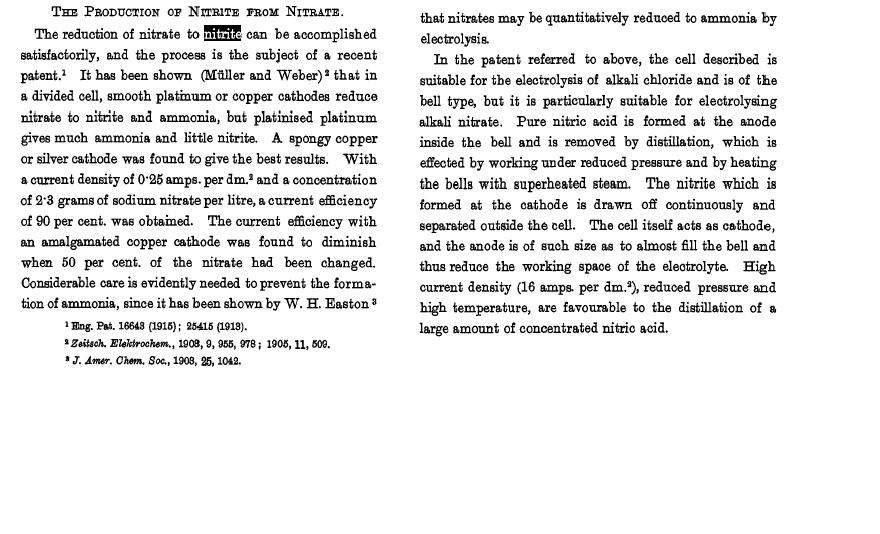silonyl
Harmless

Posts: 23
Registered: 18-7-2005
Member Is Offline
Mood: No Mood
|
|
electroreduction of NO3- to NO2-?
I'm not so good with electrochemistry, and searching didn't yield much on this topic. I'm interested in the possibility of electrolytic reduction of
ionic nitrates, either in solution or in the melt, to ionic nitrites. Is this a reasonable idea?
|
|
|
silonyl
Harmless

Posts: 23
Registered: 18-7-2005
Member Is Offline
Mood: No Mood
|
|
I suppose I should have been more specific: I'm interested in the feasibility of the specific reduction of nitrate to nitrite without significant
further reduction to lower oxides of nitrogen (or to dinitrogen). I know electrode materials can significantly affect the reaction pathways, but I
don't have a good understanding of how, so any insights would be appreciated.
|
|
|
12AX7
Post Harlot
    
Posts: 4803
Registered: 8-3-2005
Location: oscillating
Member Is Offline
Mood: informative
|
|
Hum... I know Al and Mg (metal) tend to reduce NO3- to NH3, in the absence of dichromate or boric acid buffer. That's too far, so mebbe you can add
some acid and do a metal+HCl reduction thing (Fe or Zn)?
Electrically you should be able to do the same thing in the cathode electrolyte, but that would turn basic while the anode grabs up the nitrate
ions...
Tim
|
|
|
The_Davster
A pnictogen
      
Posts: 2861
Registered: 18-11-2003
Member Is Offline
Mood: .
|
|
I have accidently reduced nitrate to ammonia during an electrolysis, I should have tested the solution after for nitrite, it did not even occur to me
then. It might be somewhere to start at least...
Checked a couple of books, see the attachment for a relavent excerpt from "the Manufacture of Chemicals by Electrolysis"

|
|
|
woelen
Super Administrator
        
Posts: 7977
Registered: 20-8-2005
Location: Netherlands
Member Is Offline
Mood: interested
|
|
I have done a lot of experimenting with electrolysis of KNO3 to see if I can get nitrite at the cathode, but all was in vain. I obtained NH3 (smell)
and gas bubbles (I think H2 and maybe some N2). Now I understand what I did wrong. I used concentrated solutions and this .JPG talks about 2.3 grams
of NaNO3 per litre. That is a very low concentration. I did experiments with copper wire, thin silver wire and also with aluminium strips. All
experiments were without success.
From all this information I conclude that making nitrite electrolytically hardly is interesting. It is a hell of a job to isolate the small amounts of
nitrite from such a dilute solution and the nitric acid formed also is a problem (it decomposes nitrite easily).
Luckily I have no need to go through all this trouble anymore  . I bought a kilo
of NaNO2 for just $12.50 (excl. international overseas shipping). To thrustworthy members of this forum I'm willing to U2U the address for the source.
No responses to SWIM and Co . I bought a kilo
of NaNO2 for just $12.50 (excl. international overseas shipping). To thrustworthy members of this forum I'm willing to U2U the address for the source.
No responses to SWIM and Co  . .
[Edited on 20-2-06 by woelen]
|
|
|
Madandcrazy
Hazard to Others
  
Posts: 117
Registered: 11-5-2005
Member Is Offline
Mood: annoyed
|
|
Hmm,
interested -NO3 to NO2 per electroreduction.
I know for instance NaNO2 is produced when NaNO3 is molten with lead to PbO and NaNO2 in the calculated amounts and for two hours stirred, the NaNO2
is separated with H2O from the PbO.
Maybe interrested to the topic is when the ammonium chloride is splitted per electrolysis to produce dilute ammonium hydroxide and HCl (NH3 and Cl2).
[Edited on 5-3-2006 by Madandcrazy]
|
|
|
cabrero
Harmless

Posts: 5
Registered: 1-12-2006
Location: europe
Member Is Offline
Mood: No Mood
|
|
NO3- is electroactive in the cathode (Ni, Cu, Fe....and many others) , to get diverse reaction products; you can change Temperature and intensity
(voltage) to obtain NH3, N2, oxides of nitrogen, ...
|
|
|